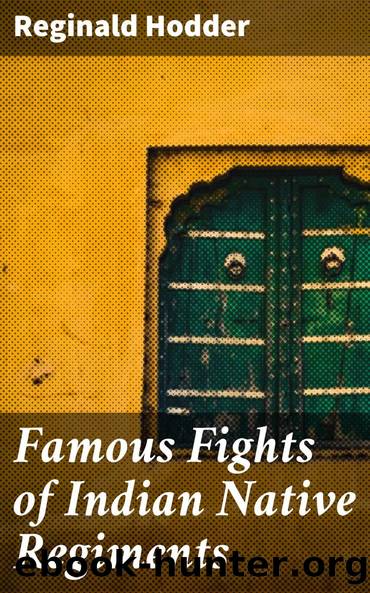Famous Fights of Indian Native Regiments by Reginald Hodder

Author:Reginald Hodder [Hodder, Reginald]
Language: eng
Format: epub
ISBN: 9781406883817
Google: 2grzswEACAAJ
Publisher: Pbshop.CompanyUK Limited DBA Echo Library
Published: 2017-07-18T00:55:37+00:00
* * *
BHURTPORE
(1826)
If any fortress in India could have been with good reason called impregnable, that fortress was Bhurtpore. In the early years of the nineteenth century the chiefs and rajahs of Hindustan were wont to say, "Yes, you may bully us, but go and take Bhurtpore!" Their belief in its impregnability was well founded, for in 1805 Lord Lake had attacked it vigorously, but had failed to reduce its well-fortified works manned by staunch and numerous defenders. After suffering terrible losses he was compelled to withdraw, leaving this Jat fortress with a still stronger claim to impregnability than it had ever possessed before.
When it was once decided by the British Government that Bhurtpore must fall, the question immediately arose, where was the man to take it? The East India Company Directors interviewed the Duke of Wellington, asking him to find a man capable of taking this fortress. The Duke gave them an answer. He said, "You can't do better than have Lord Combermere. He's the man to take Bhurtpore." "But," replied the directors with great surprise, "we thought that your Grace had not a very high opinion of Lord Combermere, and did not consider him a man of genius." "I don't care a tuppenny damn" (that was the Iron Duke's favourite par of exchange in hot words) "about his genius. I tell you he is the man to take Bhurtpore!" And the Duke was right.
There were 25,000 men in the Bhurtpore garrison, and they represented the most warlike races of India. When Lord Combermere set out with Bhurtpore as his objective, his army consisted of 30,000 men of very mixed quality. On reaching the fortress he began with heavy bombardment. Then for a week he carried forward his siege works, covered by Gurkha sharpshooters, whose eyes were so keen and whose aim so sure that no man of the enemy could show his head above the ramparts with impunity.
Point after point was won until, at last, a small breach was made by the artillery; and into this breach Lord Combermere flung a force in which were included 600 dismounted men from the various cavalry regimentsâeighty from the 11th Light Dragoons, eighty from the 16th Lancers, 200 from Skinner's Horse, and forty from each regiment of native cavalry.
Skinner's Horse is one of the earliest formed of the many distinguished Native Irregular Cavalry Corps which have fought for Britain. They had been under Colonel Skinner for many years, and had served him in many wars; thus they had come to respect and love him as tribesmen do their chief. There is a touching story of their valour and faithfulness during the storming of Bhurtpore. A party was told off according to rota duty, for the whole regiment had volunteered for the dangerous service. Skinner placed at their head Shadull Khan, one of his oldest, most faithful, and trustworthy native officers. Then he spoke to them as follows: "This is the first time you are going into danger when I cannot accompany
Download
This site does not store any files on its server. We only index and link to content provided by other sites. Please contact the content providers to delete copyright contents if any and email us, we'll remove relevant links or contents immediately.
The Memoirs of Pere Labat, 1693-1705 by Jean Baptiste(175)
Water by John Boyne(136)
The Memoirs of Count Grammont â Complete by Hamilton Anthony Count Walter Scott(111)
Famous Fights of Indian Native Regiments by Reginald Hodder(105)
A History of the Peninsular War, Vol. 5, Oct. 1811-Aug. 31, 1812 by Charles Oman(100)
1916 - The Battle of the Five Empires: 15 May - 28 September 1916 by Benoît Chenu(95)
Maleficium: Witchcraft and Witch Hunting in the West by Gordon Napier(91)
Life of Napoleon Bonaparte, Volume I. by Walter Scott(87)
Evolution Of The Japanese, Social And Psychic by Sidney Lewis Gulick(86)
The Apollo Moon Missions by Randy Walsh(83)
Famous Reviews, Selected and Edited with Introductory Notes by R. Brimley Johnson by Various R. Brimley Johnson(82)
Joanna of Flanders by Julie Sarpy(76)
Memoir of the Life and Services of Vice-Admiral Sir Jahleel Brenton, Baronet, K.C.B by Various Henry Raikes(73)
Fry The Brain: The Art of Urban Sniping and its Role in Modern Guerrilla Warfare by John West(73)
Inns and Taverns of Old London by Henry C. Shelley(71)
Elizabethan Demonology by Thomas Alfred Spalding(68)
Rasputin the Rascal Monk by William Le Queux(67)
History of the Revolt of the Netherlands â Complete by Friedrich Schiller(65)
A Winter Tour in South Africa by Frederick Young(63)
